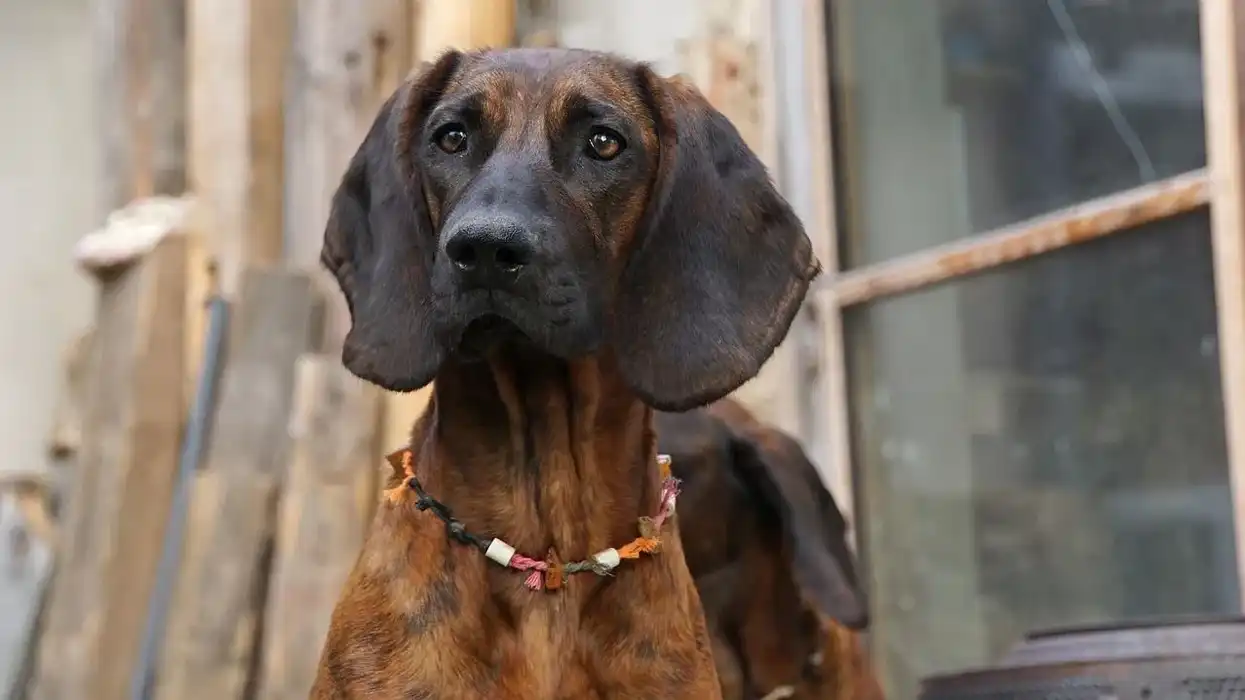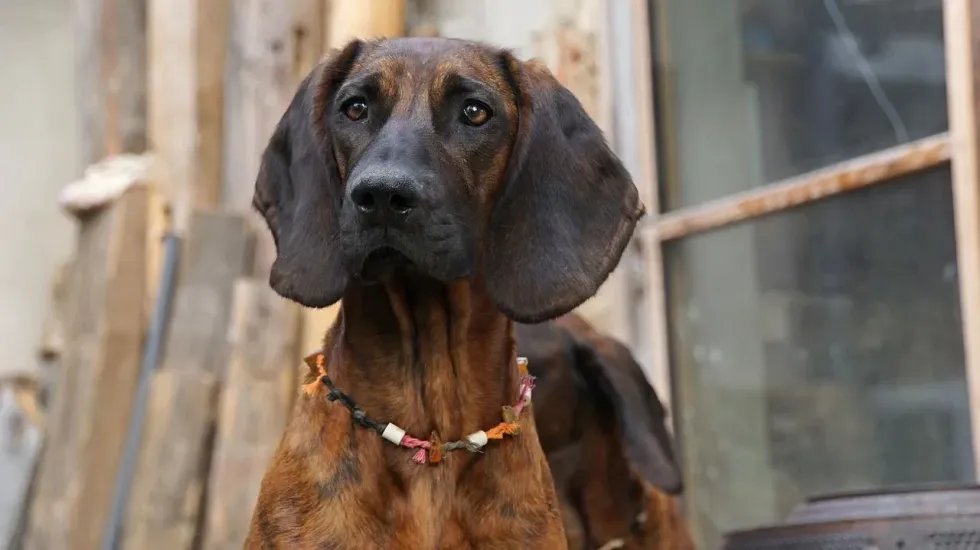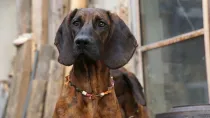Fun Bloodhound Facts For Kids
Placed under the category of one of the most loved and popular pooches, is the breed of large-sized bloodhounds. In some regions, they are also known as 'blooded hound'. Be it their looks, temperament or the exceptional brilliancy to sniff, the bloodhounds present a class of intriguing and fascinating canines.
Originally bred to hunt, today mostly these canines are used by task force to sniff trails. Beside their remarkable olfactory receptors, bloodhounds possess a gentle and mild mannered temperament.
They are loyal with sweet and warm dispositions. However, these adorable pooches can be equally willful and determined. The coat color of the breed is usually black, tan or red depending on the types of hounds.
One of the most popular on-screen portrayal of a blood hound is Pluto, Disney famous character. Bloodhound dogs are used by law enforcement agencies for tracking animals and criminals as they can follow a scent with single minded focus, after up to 300 hours of the suspect having left.
So in case of roused interests, scroll down to read some amazing and interesting facts about the blooded hound.
Bloodhound Interesting Facts
What type of animal is a bloodhound?
Bloodhound or Canus lupus are the members of Canidae family that is a group of dogs. These are large sized dogs recognized by loose folds of wrinkled skin particularly covering their eyes and face.
They can pick up a trail even after several days from a crime scene and follow it with a single minded focus.
This is the reason that bloodhounds are used in various rescue missions as well as to find some missing person. Proper training is necessary for this rescue dog to hone its trail picking skills.
What class of animal does a bloodhound belong to?
The bloodhounds belong to Class Mammalia; that is organisms that directly give birth to young ones and possess mammary glands for the nourishment of their babies. These are working dogs that have been bred for rescue and tracking purposes. Law enforcement agencies find the services of a bloodhound very useful.
How many bloodhounds are there in the world?
There are no specific numbers allotted to the total number of bloodhounds presently inhabited on earth. However these species are not enlisted by IUCN under any category of animals facing the threat to extinction so it can be safely said that their population is quite stable.
Where does a bloodhound live?
The bloodhounds can easily adapt to apartments and houses irrespective of the size, however their large is comparative preferable for either large apartments or if smaller then with a backyard. Bloodhounds are quite adaptable, as long as they are getting sufficient exercise particularly sniffing excursions.
What is a bloodhound's habitat?
Bloodhound is a large dog breed, hence these working dogs must be kept in houses with ample backyard space. Many law enforcement agencies also rear bloodhounds to follow trails from a crime scene and search for any missing person. They require regular exercise and training to remain fit.
Who do bloodhounds live with?
Bloodhounds are gregarious animals. They are extremely friendly dogs so much so that they are even overly cordial with strangers. As for their family, they are very warm and loving; affectionate around children or the other pets. In fact, these canines are pack dogs and they immensely enjoy company.
How long does a bloodhound live?
The average lifespan of bloodhounds is about 7-12 years. The lifespan can be improved slightly depending on the dog's training, grooming, and lifestyle.
How do they reproduce?
The reproductive cycle of the female bloodhound begins with the onset of the estrus cycle which lasts for about 3-11 days. During this time a swelling is seen in the genital organs of females along with the blood discharge (the color of which gradually decreases towards the end of the cycle ).
It is also during this heat cycle that the females attract the dogs for mating.
The male is reported to be ready for mating when they are tall enough to penetrate the female from the rear side for the process of fertilization. Post fertilization the female after a gestation period of 60-64 days gives rise to a litter of about 8-10 puppies.
What is their conservation status?
Being one of the most popular dog breeds since long, bloodhounds do not face any threat to their existence. As such they have been listed under the 'Least Concern' category of IUCN Red List.
Bloodhound Fun Facts
What do bloodhounds look like?
Bloodhounds, a member of canidae, possess anatomical characteristics of solemn dignity but then that's just limited to looks. In terms of their behavioral temperaments these are a group of friendly (even with strangers), calm and noble canines.
Categorized under large dog species, bloodhounds have a well built body covered with loose skin specifically around their face and neck.
In fact the facial contour has deep folds or wrinkles which contributes to catching the stray particles of the scent in the atmosphere and whizzing them upwards, in order to incorporate them in the canines nose and memory.
Bloodhounds have brawny skeletal frames with strong powerful bones. These canines without any setbacks quite easily make up to the category of canines that hunt by smell.
Though they are not really a hunting dog however they possess well equipped olfactory receptors that attracted them to go chasing after interesting scent trails. Bloodhounds are available in quite restricted color tones such as black and tan, liver and tan, and red with a tinge of white here and there.
The distinctive appearance features are deep-set eyes, drooping long ears, short hair, wrinkles on the dog's skin and an expression of calmness.
How cute are they?
Popularly known for their sweet and gentle temperament the bloodhounds are excellent at socialization. With shaggy jowl, dropping ears and deep set beady eyes bloodhounds are quite a cute category of pooches to gaze upon.
How do they communicate?
Belonging to the family of dogs, bloodhounds use the common auditory methods such as whining, howling and baying to communicate. However the bark of these canines is comparatively distinct and quite interesting.
Bloodhounds are known to produce mellow sounds which is one of their many peculiar characteristics. ‘Bay’ and ‘Roo’ are some specific noises made by these pooches. In fact the melodious vocals of bloodhound contributes to the categorization of these dogs amongst the melodious breeds of canines.
How big is a bloodhound?
Bloodhounds are large sized dogs. The average height of a Male is about 25–28 in while that of a female is about 23–26 in.
How fast can a bloodhound run?
In order to search and find any missing person, the speed of a bloodhound can go up to 40 mph after catching the scent, with proper exercise and training.
How much does a bloodhound weigh?
The male bloodhound on an average weighs about 101–119 lb while the female bloodhound weighs about 88–106 lb.
What are their male and female names of the species?
As bloodhound is a member of family Canidae, a male bloodhound is referred to as dog while the female bloodhound is referred to as bitch.
What would you call a baby bloodhound?
The young one of a bloodhound is called a bloodhound puppy.
What do they eat?
The common diet of the bloodhound includes salmon, vegetables, eggs, chicken, fish, cottage cheese and brown rice.
Are they aggressive?
Known for their docile, calm and forbearing attitude, the bloodhounds are not an aggressive or hostile breed of canines. They are usually friendly (sometimes overly so).
However since all dogs even within the same breed differ from one another, sometimes (though rarely) bloodhounds may act aggressive on grounds for a number of reasons, such as when threatened or continuously provoked.
Though generally on a large scale the bloodhounds are mild-mannered canines, at times have been observed to be mischievous and naughty and that's the closest they reach to the category of ill-behavior. The mischievous behavior can be kept under check with firm leadership during the canines growing years.
Would they make a good pet?
Belonging to a breed of dogs that are placid, mild-mannered and gentle, the bloodhound do make great pets. They are excellent with children, these canines are quite known for their benign temperaments with kids.
The kindliness of these dogs is so much so that they let the toddler get all over them and all that with every ounce of patience.
Besides children these canines are good with senior citizens as well as other pets and animals. However though their demeanor is calm and gentle, the bloodhounds are known to be mentally independent and determined.
This behavioral aspect is particularly practiced by them when the receptors of their olfactory organs get all sensational thereby catching on an interesting scent.
In such cases they may tend to overstep commands and chase after the trail on their own. Since bloodhounds tend to be super active breeds of canines with high needs of exercise, therefore they settle particularly better in an active household one that can keep up with their needs as well.
Did you know...
The hound is known to have a sense of olfaction that is about 40 times more susceptive than that of human beings.
The bloodhound's olfaction sense are known to be so authentic and dependable that a number of judicial bodies in America allow and hold the testimony of their nose work as attestation.
The famous character from the Beverly Hillbillies, Duke the Bloodhound was initially played by Stretch a bloodhound. However later when the show proceeded a younger hound was brought aboard to play the character.
The origin of the hound dates back to the year 1300 and its root can be traced to the soils of Great Britain. The ancestors of the hound are known to have descended from Belgium and France.
During the second World War, these canine hound breeds were standing on the threshold of extinction particularly in Britain. However, it was only the exported bloodlines of the blood hound that came to aid these canines' dying numbers.
How far can a bloodhound smell?
The range of bloodhound's olfactory senses are quite commendable. Due to the presence of about 300 million receptors in their sense organs, once after determining an odor, these canines are known to keep up with the scent trails for as far as 130 miles and sometimes beyond.
The sense of detecting odors is so strong in these canines that they are known to follow a trail almost about 12-13 day (300 hours) old.
Why do bloodhounds have wrinkles?
Bloodhounds are canines with the characteristics combinations of a number of beneficial features, right from droopy jowls, big long ears, to the shawl (that is big loose wrinkled folds about the neck and face).
These anatomical structures contribute to the hound's adorability as well as form the basis of their work life. The wrinkles of the bloodhound's in fact contribute to exceptional olfaction (the capacity of smelling).
They account for the ability of the canine to keep up with scent trails of the past several days.
When the receptors present in the floppy ears and nose (pressed to the ground) of these hounds acquire the particles of scent present around them they immediately hasten them upward. However, some of these odor particles are caught up in the wrinkles present on the hound's face and neck (the shawl).
These entrapped scent particles serve as a referral for the trail that the bloodhound is following, as the odor is imprinted and reinforced in the nose and memory of these canines.
Here at Kidadl, we have carefully created lots of interesting family-friendly animal facts for everyone to discover! You can even occupy yourself at home by drawing one on our Bloodhound coloring pages.
We Want Your Photos!
More for You
See All
Bachelor of Arts specializing in English Literature

Akinwalere OlaleyeBachelor of Arts specializing in English Literature
As a highly motivated, detail-oriented, and energetic individual, Olaleye's expertise lies in administrative and management operations. With extensive knowledge as an Editor and Communications Analyst, Olaleye excels in editing, writing, and media relations. Her commitment to upholding professional ethics and driving organizational growth sets her apart. She has a bachelor's degree in English Literature from the University of Benin, Edo State.
Disclaimer
1) Kidadl is independent and to make our service free to you the reader we are supported by advertising. We hope you love our recommendations for products and services! What we suggest is selected independently by the Kidadl team. If you purchase using the Buy Now button we may earn a small commission. This does not influence our choices. Prices are correct and items are available at the time the article was published but we cannot guarantee that on the time of reading. Please note that Kidadl is a participant in the Amazon Services LLC Associates Program, an affiliate advertising program designed to provide a means for sites to earn advertising fees by advertising and linking to Amazon. We also link to other websites, but are not responsible for their content.
2) At Kidadl, we strive to recommend the very best activities and events. We will always aim to give you accurate information at the date of publication - however, information does change, so it’s important you do your own research, double-check and make the decision that is right for your family. We recognise that not all activities and ideas are appropriate for all children and families or in all circumstances. Our recommended activities are based on age but these are a guide. We recommend that these ideas are used as inspiration, that ideas are undertaken with appropriate adult supervision, and that each adult uses their own discretion and knowledge of their children to consider the safety and suitability. Kidadl cannot accept liability for the execution of these ideas, and parental supervision is advised at all times, as safety is paramount. Anyone using the information provided by Kidadl does so at their own risk and we can not accept liability if things go wrong.
3) Because we are an educational resource, we have quotes and facts about a range of historical and modern figures. We do not endorse the actions of or rhetoric of all the people included in these collections, but we think they are important for growing minds to learn about under the guidance of parents or guardians.







